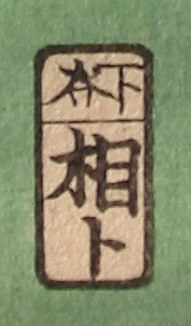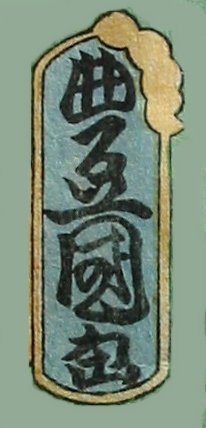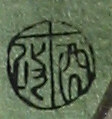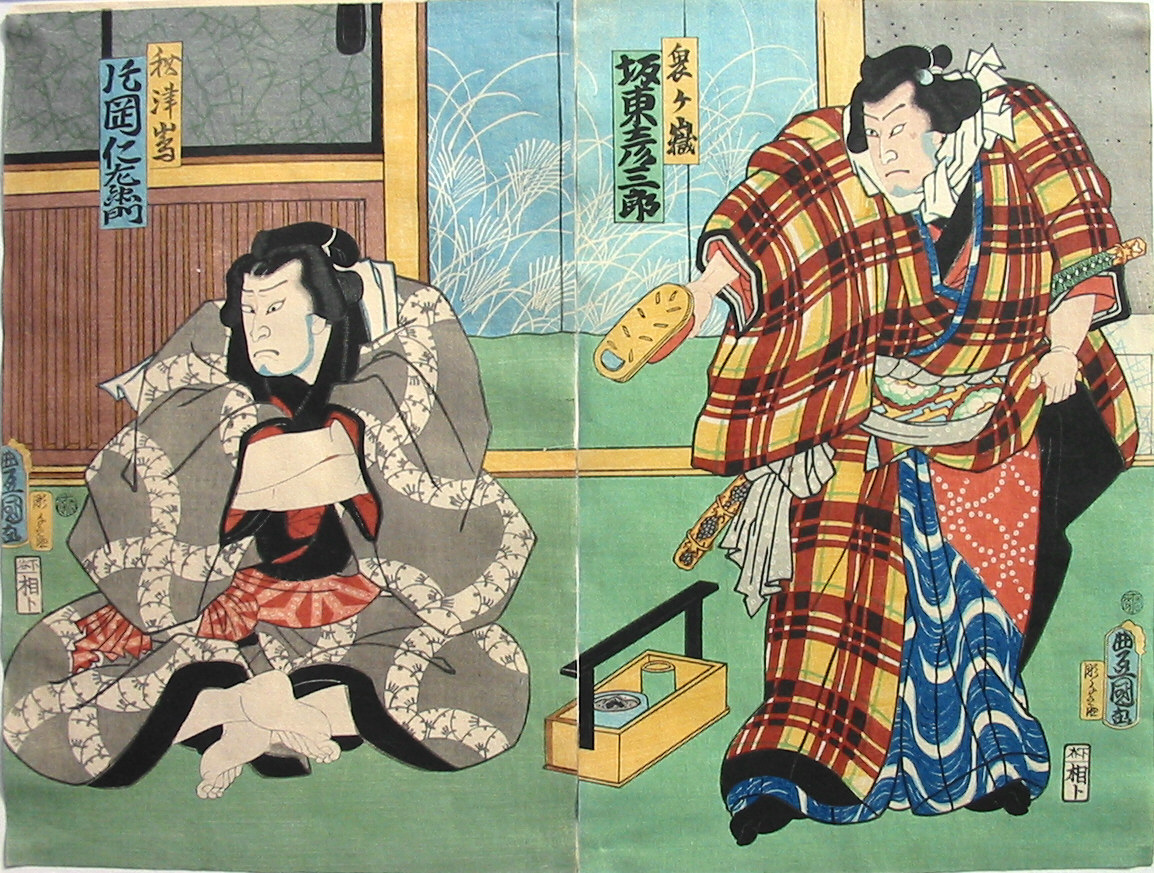 |
JAPANESE PRINTS
A MILLION QUESTIONS
TWO MILLION MYSTERIES
Ukiyo-e Prints浮世絵版画 |
|
Port Townsend, Washington |
|
UTAGAWA TOYOKUNI III |
|
三代目歌川豊國 |
|
1786-1865 |
|
Bando Hikosaburō V 坂東彦三郎 (right Panel) as the sumo wrestler Onigadake Dōemon and Kataoka Nizaemon VIII 片岡仁左エ門 as Akitsushima (秋津島 or あきつしま) Kuniemon |
|
Scene from the play Sekitori Nidai no Shōbuzuke |
|
関取二代勝負附 |
|
せきとりにだいのしょうぶづけ |
|
Two panels of a triptych possibly |
|
Date: 1861, 12th Month |
|
Bunkyū 1 |
|
文久1 |
|
Signed: Toyokuni ga 豊国画 |
|
Publisher: Aito |
|
柤卜 |
|
あいと |
|
Carver: As yet unidentified |
|
Print Sizes: 14 1/8" x 9 1/4" |
|
Mat Size: 18 1/2" x 23 1/8" |
|
There is another copy of this diptych at the Victoria and Albert Museum. |
|
Originally $483.27 Now on sale for $330.00 SOLD! |
| Sekitori Nidai no Shōbuzuke |
|
This play was originally written for the puppet theater by Hachimin Heishichi in 1768. Based on a rivalry between two major sumo wrestlers. "When Kuniemon is insulted by his rival, he commits seppuku, but his spirit returns and possesses his son, Kunimatsu, who defeats Dōemon in the ring."
Quote from: New Kabuki Encyclopedia: A Revised Adaptation of kabuki jiten, by Samuel L. Leiter, 1997, p. 627.
Thirty one years previously Kunisada, aka Toyokuni III, portrayed Bandō Mitsugorō as Akitsushima Kuniemon in a scene from this play.
I am only guessing here because I have been unable to locate a text of this play, but it would seem logical given the images below that the insult was made with the sandal. That is one of the elements found in several prints which we have shown on this site including the scene of the maid Ohatsu wiping Onoe's blood from her sword. This was in revenge for the insult of Ohatsu's virtuous mistress and her subsequent suicide.
The use of the shoe was made eminently clear a few years ago when the statue of Sadaam Hussein was torn down in Baghdad. At that time a number of bystanders struck the fallen head with their shoes. Obviously it isn't just a Japanese phenomenon. |
|
|
|
SEKITORI 関取
In the 15th century the highest ranking practitioners of sumo were referred to as sekimori of "guardians of the barrier." Seki means barrier. By the Edo period sekimori had evolved into sekitori. "Promotion to sekitori marks the sumitori as a professional. His life changes drastically. His appearance is marked by the ginko-leaf-style topknot (oichomage) as opposed to the plain topknot he has been wearing." During practice he wears a white belt and not a black one. He can wear a tournament belt made of silk and can have a fan club. Also, he "...must face fifteen opponents during a sumo tournament as opposed to his previous seven matches."
Source and quotes from: The Essential Guide To Sumo, by Dorothea M. Buckingham, Bess Press, Honolulu, 1994, pp. 158-59. |
|
Above is mentioned the oichōmage or ginko-leaf-style topknot. Ichō (銀杏 or いちょう) means ginko or maidenhair tree. Alone the first character 銀 means silver and 杏 means apricot or apricot tree. Hence, oichōmage means large ginko leaf topknot.
The casual hairstyle was the chonmage (丁髷 or ちょんまげ) or town topknot. Even the highest ranking sumo wrestlers wore this in their off time as did many men seen in the street.
According to Dorothea Buckingham the oichōmage rests on a three inch shaved bald spot. The tokoyama (床山 or とこやま) or hairdresser must apprentice for ten years before he can create this style. He uses a pomade scented by camellias or bintsuke (鬢付け or びんつけ). "He then ties the topknot over the bald spot with motoyu (paper string) and fans it into the shape of a ginko leaf."
Ibid., p. 144. |
|
THE TOKOYAMA HAIRDRESSER TO THE STARS
Remember when Bill Clinton got a $200 haircut from Christophe while aboard Air Force One while it sat on the tarmac at LAX in May 1993? Even if you don't it should make the point that special people get special treatment and that brings me around to a discussion of the tokoyama. There are hairdressers and there are hairdressers, but in Japan the tokoyama's role is special: He only does the hair of kabuki actors or the top ranked sumo wrestlers and in the case of the latter he is a sumo wrestler himself, but of lower status.
Most sumo 'stables' have at least one tokoyama and sometimes up to four. Poorer stables often have to share hairdresser. As mentioned above a specialist has to train for ten years before he can even consider creating the ginko-leaf-style topknot. It is his job to dress the hair of the sekitori every day. "During a tournament he may dress the hair of a sekitori several times - before his ring-entrance ceremony, before his fight, and during the TV interview before an awards ceremony." TV? Well, I can't image it was much different before the invention of the boob tube. Can you?
Ibid., pp. 193-4 |
 |
||||
 |
Carver's Seal: Unidentified (I have included both of these seals for comparison.) |
|||
 |
||||
| Publisher: Aito |
 |
 |
||
|
Artist's Signature: Toyokuni ga |
Date Seal: 1861 12th Month |
|
THE FINEST KABUKI SITE ON THE INTERNET! |
|
|
|
For additional information about KATAOKA NIZAEMON VIII link to the web site below. |
|
|
|
For additional information about BANDO HIKOSABURŌ V link to the web site below. |
 HOME
HOME |
